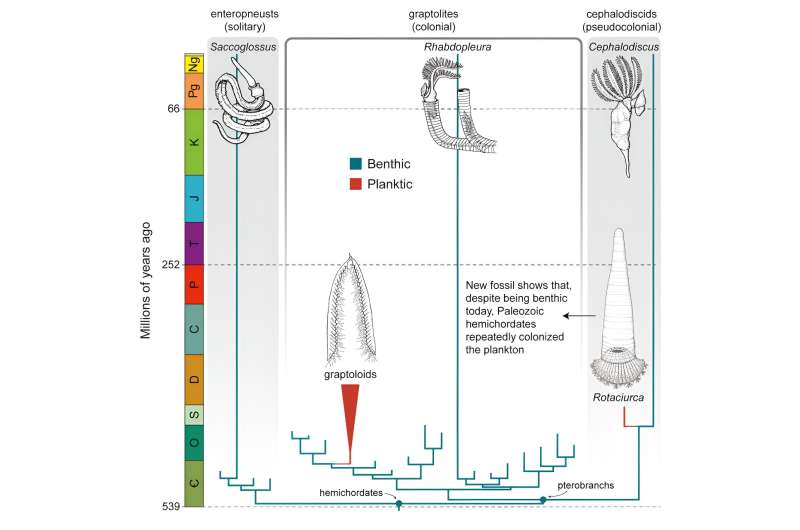This article has been reviewed according to Science X's editorial process and policies. Editors have highlighted the following attributes while ensuring the content's credibility:
fact-checked
peer-reviewed publication
trusted source
proofread
The last turn of 'Ezekiel's Wheel' honors a fossil hunter

The mystery of Ezekiel's Wheel—the extinct sea creature, not the Biblical vision—may have taken its final turn, thanks to Yale paleontologists. In so doing, the researchers have also finally put a scientific name to the favorite fossil of a beloved amateur fossil hunter.
Samuel J. Ciurca Jr., who died in 2021, was a curatorial affiliate of the Yale Peabody Museum for many years. He collected tens of thousands of fossils, primarily from the Silurian rocks of upstate New York and southern Ontario, Canada. He donated more than 11,000 fossil sea scorpions, called eurypterids, to the Peabody Museum—the Ciurca Collection in the Peabody's Division of Invertebrate Paleontology.
One of these, which is perhaps the largest complete eurypterid ever discovered, is a specimen, 1.25 meters in length, of the giant pterygotid Acutiramus macrophthalmus, which will be on display when the Peabody re-opens to the public in 2024 after a multi-year renovation.
But while the vast majority of Ciurca's fossils are eurypterids—extinct sea scorpions found throughout most of the world in rocks ranging in age from 465 to 250 million years—his favorite fossil was something else entirely. Something unidentified.
He called it Ezekiel's Wheel, after the Old Testament reference to the prophetic vision of a warrior in a wheeled chariot. Ciurca discovered 10 specimens of the unknown animal in Ontario, starting in the mid-1990s.
"He inscribed the back of the best specimen, the first example he discovered, with the words, 'the most beautiful fossil ever found,'" said Derek Briggs, the G. Evelyn Hutchinson Professor of Earth & Planetary Sciences in Yale's Faculty of Arts and Sciences, and a longtime associate of Ciurca.
The small specimens consist of a circular aggregate of radiating tubes arranged in two or more levels—thus the "wheel" nickname. The length of the tubes is as much as three-quarters of an inch.
"Ezekiel's Wheel has long been a mystery," Briggs said. "Several years ago, a then-graduate student of mine, Nicolás Mongiardino Koch, tried to figure out what it was as a class project for my course 'Extraordinary Glimpses of Past Life.'"
"He made significant progress on a solution, but additional specimens that came to light when we acquired more of Sam's collection after he died added important new information."
"With a new investigation," Briggs added, "we now have an answer to the mystery."
In a new study published in the journal Current Biology, Briggs and Mongiardino Koch, who is now at the University of California at San Diego, identify Ezekiel's Wheel as a 420-million-year-old representative of a group still found in the modern oceans, known as hemichordates.
Although hemichordates are now rare, their ancestors were quite abundant. The most common were known as graptolites, and they were often found in Paleozoic plankton; graptolite fossils play an important role in correlating sedimentary sequences in research.
Less common ancient hemichordates were creatures called cephalodiscids, which are still alive today. Both their living and extinct forms lived exclusively on the seafloor—or so it was thought.
"It turns out Sam's fossil is a very unusual cephalodiscid which evolved a conical structure that we interpret as a float—it is the only cephalodiscid known to have colonized the plankton," Briggs said.
The researchers named it Rotaciurca superbus: "rota," which is Latin for "wheel," "ciurca" after the fossil hunter who thought it was beautiful, and "superbus," the Latin word for "splendid."
They assigned Rotaciurca superbus to a new family, Ezekielidae, highlighting its status as an extinct fossil cephalodiscid outside the living group.
More information: Derek E.G. Briggs et al, A Silurian pseudocolonial pterobranch, Current Biology (2023). DOI: 10.1016/j.cub.2023.10.024
Journal information: Current Biology
Provided by Yale University





















